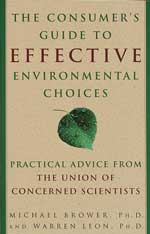Finally! A sensible list of things we can do to save the planet!
Discussion on this topic has been muddled since the 50 Simple Things book came out years ago. It was a well-meant list and a very popular one. Its sales showed that millions of folks, especially young folks, are willing to change their ways in order to preserve their life support systems. If only someone would explain how our ways need to change!
Starting with 50 Simple Things, on through endless debates over paper versus plastic grocery bags and washable versus disposable diapers, we have been inundated with advice about greener ways to live. The advice has been contradictory — every study about the wastefulness of, say, disposable pop bottles is quickly matched with a counter-study, usually industry-sponsored, showing that pop bottles are not so bad. The advice has been picky — I for one never got around to putting a brick in my toilet tank to reduce the water used per flush. Above all, the advice has been trivial — keeping our tires properly inflated just isn’t a convincing answer to global warming.
To the rescue, at last, comes the Union of Concerned Scientists, with a book called The Consumer’s Guide to Effective Environmental Choices. It takes a comprehensive look at the many ecological impacts of the stuff we put through our lives, including the stuff it takes to make the stuff. In a surprisingly understandable appendix, it explains its calculations and data sources. Finally it sorts out the consumer choices that really make a difference. “By the end of the book,” the authors write, “we hope you will never again consider purchasing a gas-guzzling car, but by the same token, you won’t feel guilty about using disposable diapers, spray cans, or paper napkins.”
The book is full of interesting details. Refrigerators are the biggest energy users among household appliances. Houses with extra insulation and high-efficiency windows can cost $5,000 to $10,000 more to build, but will use one-fourth as much heating and cooling energy, so the extra cost is paid back after just a few years. Traveling a mile on a snowmobile, powerboat, or other two-stroke off-road vehicle causes 10 times as much pollution as that same mile on a four-stroke on-road motorcycle, and 15 times as much as in a car.
I could go on with the factoids, and I’d like to tell you about the chapter on what the government can do, but there’s only room here to get to the bottom line. Here are the top things the UCS book says consumers can do to help the environment. Many of them have to do with transport, because that’s where we do the most damage and so have the most opportunity to clean up our act.
1. Choose a place to live that reduces your need to drive.
2. Think twice before buying a second car. Not only will that save the pollution involved in making the second car, but it will also force more thoughtful, shared use of the first one.
3. Match your car to your needs; get the most fuel-efficient, least polluting one possible. People who daily transport baseball teams or used furniture may need vans. People who use vans for one-person commuting are wasting money and the planet.
4. Make a travel budget. See if you can reduce your driving and air travel by 10 or 20 or 30 percent. Prepare for the time when gas will cost $5 a gallon, which it already does in Europe. Work out driving habits consistent with $40-$50 fill-ups.
5. Walk, bike, or take the bus when you can. Better for your health and your pocketbook, much easier on the planet.
6. Eat less meat. Beef and pork have the highest ecological costs, chicken and dairy products less so, grain and fruits and vegetables still less.
7. Buy certified organic produce, which is getting easier and cheaper to do as the organic market grows. Organic farming saves huge amounts of pesticides and water pollution. If you also want to save the transport of your food, plus money, plus get good exercise and much pleasure, grow your own.
8. Don’t buy more house than you need. Smaller homes use less material, cost less to heat and cool and light, store less junk. Every bit of material, warmth, cool, light, and junk comes from the planet, flows to you in a trail of pollution, and eventually goes back to the planet as waste. You’re not a bigger person if you own a bigger house; you’re just a bigger polluter.
9. Upgrade your heating and hot-water efficiency. Most American homes are energy sinks; insulating and stopping up the holes makes us more comfortable at less cost.
10. Get the most efficient appliances and lights. In order of electricity consumption, here’s the order of upgrade that will make the most difference: refrigerator, lights, television, electric dryer, stand-alone freezer, electric ranges/oven.
11. If electricity choice comes to your state, pick a company that offers “green” power. Check out the definition of green — the more wind and solar power, the better.
Almost every item on this list not only helps the environment, it also saves money and time and health. Really, the only problem with following UCS’s advice is that, if you believe the advertisers, it won’t make you admirable, beautiful, ever-young, sexy, powerful, or superior to your neighbors.
So maybe there should be one more item:
12. Turn off the advertisers.


